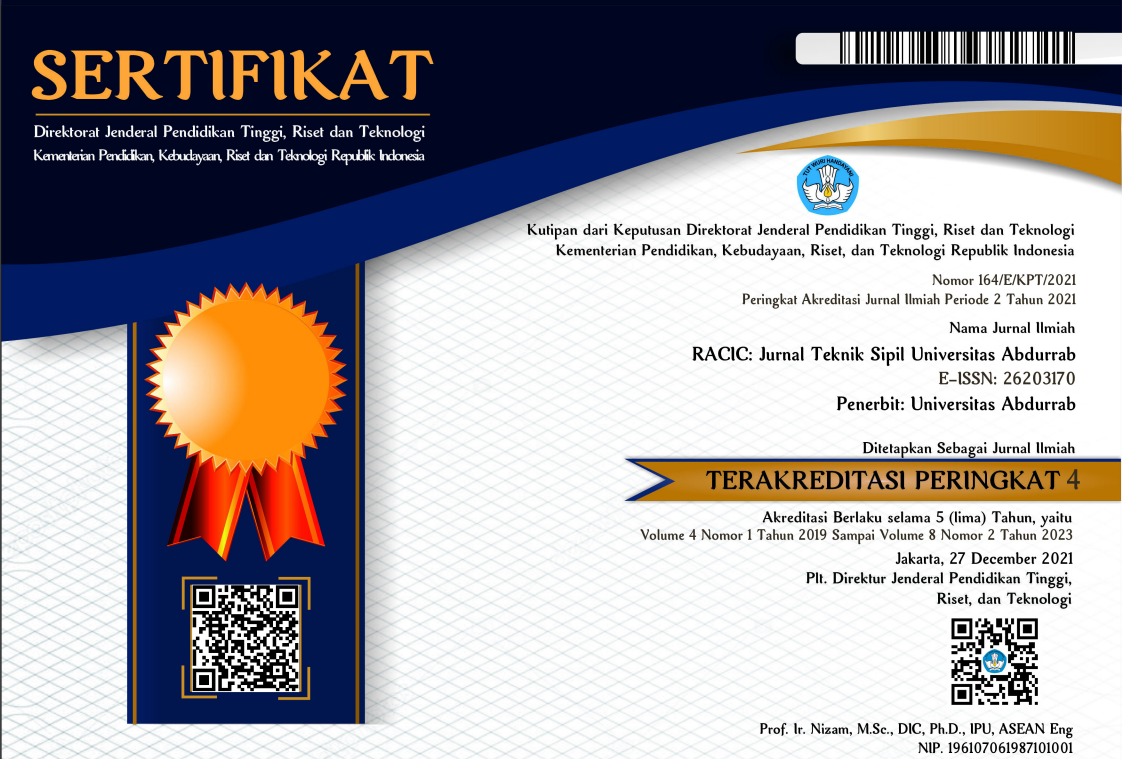PENGGUNAAN EGG SHELL POWDER (ESP) DAN SUGARCANE PULP ASH (SPA) SEBAGAI BAHAN STABILISASI TERHADAP KUAT DUKUNG TANAH LEMPUNG
DOI:
https://doi.org/10.36341/racic.v8i1.2919Keywords:
Egg Shell Powder, Sugarcane Pulp Ash, stabilization, ClayAbstract
Repairs to clay soils generally use stabilization methods to improve the properties of clay soils with additional materials mixed in the original clay soil to increase the soil bearing strength according to technical specifications in building construction. Egg Shell Powder (ESP) is a waste product from households and home industries with a high enough calcium carbonate (CaCO3) content to fill the holes between the pores and glue the soil particles together. Meanwhile, Sugarcane Pulp Ash (SPA) is one of the wastes from household products and sugarcane processing that is not utilized by the surrounding community to reduce environmental pollution. The research method used in this study was laboratory testing of the water content, specific gravity, and CBR values ​​of the addition of ESP and SPA to clay with variations of 0%, 5%, 10%, and 15% and to the addition of 5% SPA. Results The original soil in this study was included in the CL soil classification, namely non-organic clay with low to moderate plasticity. The optimum water content value tends to decrease along with the addition of ESP and SPA to the original soil, namely the variation of ESP 15% and SPA, which is 19%, and the specific gravity value increases by 1,71 gg/cc. The CBR value increased with the addition of 15% ESP and 5% SPA, which was 9,23%.
Downloads
References
Amu, O.O., . A.B.F. and . B.O.O. (2005) ‘Effect of Eggshell Powder on the Stabilizing Potential of Lime on an Expansive Clay Soil’, Journal of Applied Sciences, 5(8), pp. 1474–1478. doi:10.3923/jas.2005.1474.1478.
Chong, B.W. et al. (2020) ‘Properties of concrete with eggshell powder: A review’, Physics and Chemistry of the Earth, 120, p. 102951. doi:10.1016/j.pce.2020.102951.
Das, B.M. (1988) Mekanika Tanah (prinsip-Prinsip Rekayasa Geoteknik) Jilid 1. Jakarta: Erlangga.
Dedi Irawan (2013) Pengaruh Penambahan Abu Ampas Tebu (Bagasse Ash) sebagai Bahan Stabilisator Pada Tanah Organik. Universitas Lampung.
Diana, W., Finanda, I.M. and Firdaus, H.F. (2020) ‘Pengaruh Substitusi Bubuk Cangkang Telur dan Siklus Basah Kering Terhadap Kuat Tekan Bebas Tanah Lanau yang Distabilisasi dengan Kapur’, Prosiding UMY Grace, 2020. Available at: https://prosiding.umy.ac.id/grace/index.php/pgrace/article/view/170.
Fathonah, W. et al. (2021) ‘Pemanfaatan Serbuk Cangkang Telur Sebagai Bahan Stabilisasi Tanah dan Pengaruhnya Terhadap Nilai California Bearing Ratio (CBR)’, Fondasi: Jurnal Teknik …, 10(2). Available at: https://jurnal.untirta.ac.id/index.php/jft/article/view/12462.
Fauziyah, D.N., Surjandari, N.S. and Hesti, R.H.D. (2020) ‘Pengaruh Variasi Abu Ampas Tebu Dan Bubuk Cangkang Telur Terhadap Sifat-Sifat Tanah Pada Tanah Berbutir Halus Dengan Indeks …’, Matriks Teknik Sipil, pp. 220–227. Available at: https://jurnal.uns.ac.id/matriks/article/view/44026.
Hardiyatmo, H.C. (2012) MEKANIKA TANAH 1. Enam. Yogyakarta: Gajah Mada University Press.
Munirwan, R.P., Munirwansyah, M. and Marwan, M. (2019) ‘Penambahan Serbuk Cangkang Telur Sebagai Bahan Stabilisasi Pada Tanah Lempung’, Jurnal Teknik Sipil, 8(1), pp. 30–35. doi:10.24815/jts.v8i1.13496.
Negara, H.I. (2022) Stabilisasi Tanah Lempung menggunakan Serbuk Cangkang Telur dan Kapur (CaO) 2% dengan pengujian CBR dan Kuat Tekan Bebas. Universitas Sumatera Utara.
Putra, F.R.N. and Marzuko, A. (2013) Penambahan abu ampas tebu terhadap tanah lempung dengan bahan tambah rotec terhadap parameter kuat geser tanah. Universitas Islam Indonesia.
Downloads
Published
Issue
Section
License
1. Copyright of all journal manuscripts is held by the RACIC : Rab Construction Research
2. Formal legal provisions to access digital articles of electronic journal are subject to the provision of the Creative Commons Attribution-ShareAlike license (CC BY-NC-SA), which means that RACIC : Rab Construction Research is rightful to keep, transfer media/format, manage in the form of databases, maintain, and publish articles.
3. Published manuscripts both printed and electronic are open access for educational, research, and library purposes. Additionally, the editorial board is not responsible for any violations of copyright law.
licensed under a Creative Commons Attribution-ShareAlike 4.0 International License.





